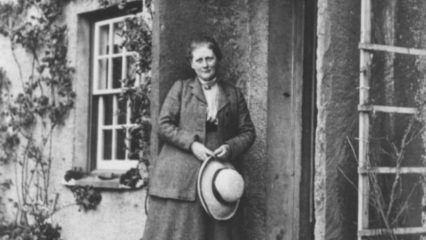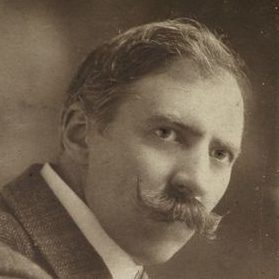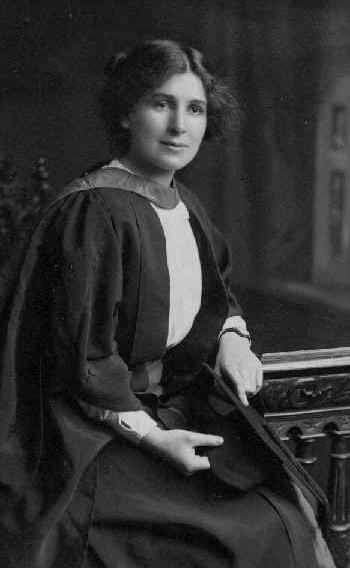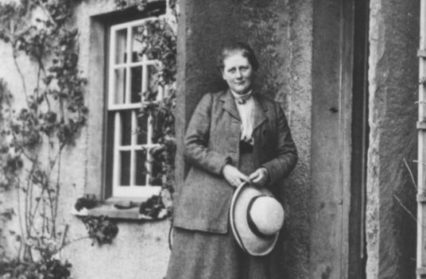In the fourth and final part of his fascinating introduction to the literary riches of Denbigh’s history, John Idris Jones charts the highlights of the twentieth century.
Twentieth Century Denbigh:
Beatrix Potter (1866-1943)

Beatrix Potter’s association with Denbigh is through the old farm residence Gwaenynog, located to the left of the A543, about a mile outside the town, on the road which makes a spectacular route through moorland westwards, through Groes and Bylchau, joining the A5 at Pentrefoelas.
Her Journals, 1881- 1897, show her reminiscing:
I could not exactly determine what distinguished the Welsh type, but it is marked, particularly among the women and girls; something about the forehead, eyes, and the fall of the nose…dark or blue eyes, red or black hair……Denbigh Asylum seemed populous…I thought it very singular that the lunatics should walk in the Park and come up to the garden railings…
In the late nineteenth century Gwaenynog Hall was owned by Beatrix Potter’s aunt and uncle Harriet and Fred. From 1895 to 1913 the author visited thirteen times: she loved the house and gardens. The kitchen garden as the setting for the story ‘The Tale of the Flopsy Bunnies’, using sketches she made there as illustrations to the book. Mr McGregor’s potting shed is there now in reality and it appears in the work. The gardens have been restored to their earlier state, with pear and apple trees, peaches, damsons, plums and herbaceous plants. Rabbits make an appearance.
T. Gwynn Jones (1871-1949)

Thomas Gwynn Jones was born in Y Gwyndy Uchaf, Betws-yn-Rhos; the eldest son of Isaac Jones and Jane Roberts. He was educated in Denbigh and Abergele. In 1899 he married Margaret Jane Davies, the daughter of Thomas Davies of Denbigh, a butcher. They had three children. In 1890 he was sub-editor of the Denbigh-published newspaper ‘Baner ac Amserau Cymru’ (Y Faner). He wrote a biography of Thomas Gee. He moved to work at the National Library of Wales, Aberystwyth, and later as a lecturer in the Welsh department, University College of Wales, Aberystwyth, where he became professor in 1919.
He won the Chair at the National Eisteddfod of Wales, Bangor, for his ode ‘Ymadawiad Arthur’ (Arthur’s leaving).
He published many volumes of verse in Welsh and became well-known in Wales for his richly written, although sometimes dense, poetry.
Prys-Jones (1888-1987)
Born in Denbigh, his father moved his family to live in Pontypridd in 1898. At the age of thirteen he went to Llandovery College and in 1908 he won a scholarship to read History at Jesus College, Oxford: he made friends with T.E. Lawrence, ’Lawrence of Arabia’, there. His working life was in the field of public education; he was awarded OBE. He wrote poems, plays and reviews. He left Cardiff in 1951, moving to Wimbledon. He and his wife Betty had two children. Don Dale-Jones edited his ‘Collected Poems’ in 1988. The poet died in Kingston-upon-Thames aged 98. This is the second stanza of his poem ‘At Valle Crucis Abbey’:
And I, in this green, hallowed place
Was drawn within the silence there,
A realm where language, time and space
Dissolved upon the crystal air;
And all the vale leapt bright with sudden change
To beauty more intense than flaring fire,
Shining with symbols rich and rare and strange,
Until in soaring music, sweet and long,
The birds about the broken choir
Poured forth their hymns of praise in ardent song.
Kate Roberts (1891-1985)

Kate Roberts was born in the village of Rhosgadfan, Caernarfonshire. Her father, Owen Roberts, was a quarryman. Her upbringing, in very modest circumstances, in a bare, upland setting, features in most of her work, which is largely autobiographical.
Her early surroundings were of a Welsh-language society centred on the local Nonconformist chapel. High levels of self-respect, pride and morality applied. Her intellect was outstanding and after graduating at the University College of North Wales, Bangor, she worked as a teacher in schools in south Wales.
She married in 1928. Her husband, Morris T. Williams, was active in Nationalist circles. He worked as a printer; they bought Gwasg Gee in Denbigh and lived in the town from 1935. She lived in the town until her death. The couple worked at the printing and publishing house, producing many books and pamphlets in Welsh; she contributed freely to the weekly newspaper ‘Y Faner’. Her husband died in 1946; she worked at the business for the following ten years.
Her books were widely bought among the Welsh readers. They are works of realism, written in the vernacular, economically constructed, with a focus on place and individual personality. She read English, French (in translation) and American authors, with a particular fondness for Zola, D.H.Lawrence and Thomas Hardy. Some of her works have been translated in to English. Outstanding among these is Traed Mewn Cyffion, translated as Feet in Chains, which depicts a quarryman’s family beset by poverty, determined to keep their dignity, through the period of the First War. Te yn y Grug (Tea in the Heather) was also translated: this is a subtle series of incidents in the life of a young girl, replicating Kate Roberts’s own young life.












